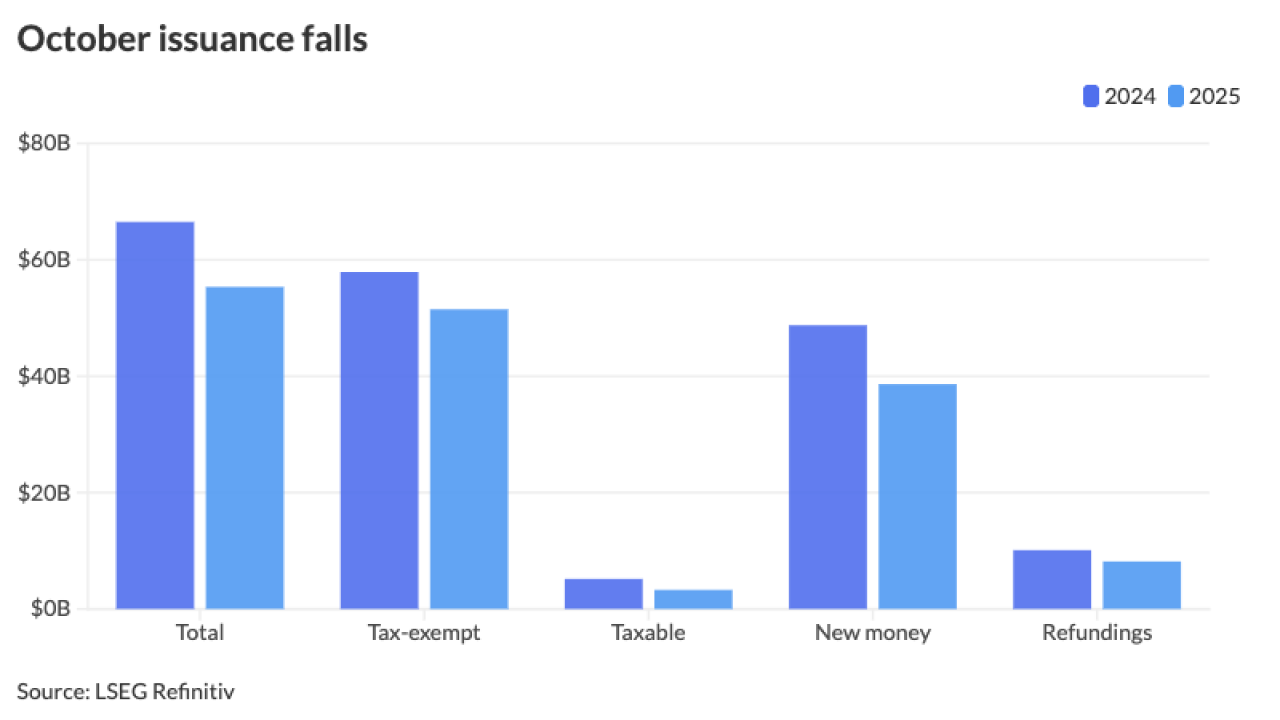The Foothill-Eastern Transportation Corridor Agency will make a tender offer next week ahead of a $785 million advance refunding in the hope of taking out some of the debt with tax-exempt bonds.
“We saw an opportunity to issue tax-exempt by offering a tender and exchange as part of the transaction, because so many issuers have used taxable to replace tax-exempts and investors had tax exempts they were looking to hold on to,” said Amy Potter, chief financial officer for the transportation agency. “If we include the tender, we can save more because issuing tax-exempt saves us more than taxables.”

The tender offering exchange is slated for Jan. 21, and the pricing on the combined tax exempt and taxable deal would occur on Jan. 25.
S&P Global Ratings, Moody’s Investors Service and Fitch Ratings all affirmed their ratings on the senior bonds in December.
S&P rates the Series 2021 senior bonds A-minus with a negative outlook, Moody's rates them Baa2 with a stable outlook, and Fitch BBB with a stable outlook, respectively.
The tender offer is an attempt to tap into unfilled demand for tax-exempt debt with so much being refunded with taxable bonds since the 2017 federal tax bill eliminated advance refundings, Potter said.
“We keep an ear to the market and listen to investors,” she said.
At first, “we were planning to just do another taxable advanced refunding like we did a year ago,” Potter said.
The agency anticipates $100 million in net present value savings on the deal, she said.
The ban on using tax-exempt debt for advance refundings spurred growth in municipal debt refundings using taxable debt, said Eric Kazatsky with Bloomberg Intelligence.
Roughly $86 billion of the $142 billion in taxable muni issuance in 2020 were refundings, nearly triple the $30 billion in taxable muni refundings done in 2019, Kazatsky said. An additional $41 billion in taxable munis were also issued using corporate CUSIPs in 2020.
After the tax bill passed, there was talk of a variety of creative structures to make up for the end of tax-exempt advanced refundings, but taxable debt has been the primary vehicle used, Kazatsky said.
Neither Kazatsky nor Potter are aware of other muni issuers that have conducted a tender offer in conjunction with a refunding of long-term bonds.
F-ECTA’s refunding would come in four tranches, taking out senior lien debt with a tax-exempt and taxable tranche, and taking out junior lien debt with a tax-exempt and taxable tranche.
Though the preliminary offering documents have not outlined the split between the four tranches, Potter said the agency has already carved out an agreement to be able to reprice about 51% of what it would like to refund as tax exempt, which is noted in the preliminary offering documents. Of the $494.2 million of senior lien debt being refunded, $285 million is subject to private exchange, and on the junior lien debt, $68 million of the $198 million is subject to private exchange, according to the preliminary offering statement.
“Once we see how much interest there is, we would then determine how much will be issued as tax-exempt, and the balance would be a taxable transaction,” she said. “When we buy back the bonds from bondholders, it converts them from an advanced refunding to current interest bonds. The existing bonds aren’t callable until 2024.”
The deal would maintain the maturity dates on the existing debt.
The refunding would enhance the agency’s ability to pay down bonds early in the future, because it would create additional cash flow. By matching existing maturities, the agency would be able to front load some of the cash flow savings, Potter said.
It would reduce payments $10 million a year in the earlier years and add to unrestricted cash flows when the agency reaches the call dates on some of the other bonds, she said.
“The board has an interest in paying the bonds off early,” she said. “Right now, the focus is on reducing overall payments to increase flexibility and improve debt service coverage.”

The Foothill-Eastern Transportation Corridor System is comprised of three connected and interdependent highways, State Route 241, SR 261 and SR 133, totaling 36 miles.
The F-ETCA is a separate legal entity from the San Joaquin Hills Transportation Corridor Agency. They both fall under the umbrella of The Toll Roads of Orange County, and are managed by the same team, but are organized as different systems with individual debt.
The F-ETCA system is owned by the state of California and maintained by the California Department of Transportation via an agreement that expires in 2053 after final maturity of the bonds.
Like many transportation systems, F-ETCA, funded through tolls and impact fees, experienced a coronavirus-driven reduction in revenues to the tune of a 28% decline in 2020 compared to 2019, according to bond documents.
“We took a super conservative approach in the budget,” Potter said. “We have liquidity, because we wanted to make sure we had enough cash to meet the bond covenants.”
She noted that the rating agencies cited the agency's strong liquidity to manage through the pandemic.
Moody’s analysts wrote that the agency's liquidity position is a key credit strength, with more than 5,700 days cash on hand in fiscal year 2020 and fiscal year 2021 estimates remain in the same range. Moody’s also cited the agency’s track record of rate increases to maintain adequate debt service coverage ratios, which analysts said they expect to continue.
“As with the broader toll road sector, F-ETCA traffic and revenues saw sharp declines in early March related to the coronavirus outbreak,” Moody’s wrote. “The declines reached their peak in April, with monthly traffic 63% down and monthly toll revenues 58% down compared to April 2019. The recovery began in May, and as of September 30th, monthly traffic was down 28% from the prior year and monthly toll revenues were down 25%.”
According to a study by consultant Stantec updated in the wake of the pandemic and included in the bond offering documents, traffic is expected to recover to fiscal year 2019 levels between fiscal year 2023 and 2026 and revenues are expected to come back in fiscal year 2022 or fiscal year 2023, depending on the recovery scenario.
Moody’s cited the agency’s robust financial metrics evidenced by its strong liquidity position, which enables it to weather economic downturns, for the stable outlook.
S&P, the only one of the three rating agencies to assign a negative outlook, said the outlook “reflects our opinion that the agency’s financial metrics could be pressured as a result of severely or materially depressed or unpredictable vehicle traffic demand for 2020 and beyond that is beyond management’s control.”
If the agency experience a material and sustained decline in toll revenues and traffic due to the pandemic, it could cause negative rating action if traffic levels and financial capacity stagnate at lower levels longer than expected, S&P analysts wrote on Dec. 4.
Goldman Sachs is the lead manager on the forthcoming refunding deal with BofA Securities, Barclays and J.P. Morgan as co-managers. PFM is municipal advisor and Stradling is bond counsel.





